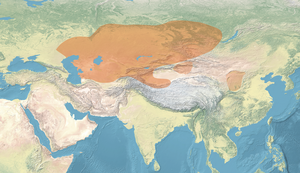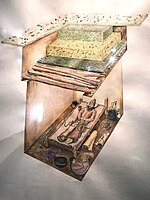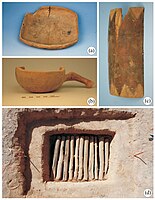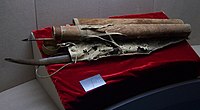스베시 문화
Subeshi culture수베시 문화의 전체적 위치, 사카 왕국( ) 옆, 그리고 아시아의 동시대 정치 325 BCE | |
| 지리적 범위 | 투르판, 신장, 중국 |
|---|---|
| 날짜 | 1100-100 BCE |
| 앞에 | 케무르체크 문화 |
| 그다음에 | 흉노, 타슈티크 문화 |
수베시 문화(Subeshi culture, 기원전 1100년-100년, Ch: 苏贝希文化)는 타림 분지의 동쪽 끝에 위치한 신장 투르판 지역에서 시작된 철기 시대의 문화입니다.수베시 문화는 후기 타림 미라의 일부에 기여합니다.그것은 중국의 사료에서 알려진 체시국(車師, 취시, 주시 왕국)과 관련이 있을 수 있습니다.이 문화에는 밀접하게 관련된 3개의 묘지가 포함되어 있습니다.
특성.
수베시 문화의 기원은 청동기 기술, 도자기, 장식 양식이 서양으로부터 전해진 뒤 동쪽으로 더 멀리 시바 문화와 같은 중국의 초기 문화로 퍼져 나간 신석기 시대 후기와 청동기 시대 초기까지 서아시아와 중앙아시아 문화의 영향을 받았습니다.00 BCE), 키자 문화 (2500 BCE-1500 BCE) 또는 차우후고우커우 문화 (800 BCE-100 BCE).[1]
수베시 문화는 알타이 산맥의 사카 파지릭 문화와 비슷한 기원전 1천년기의 철기 시대 묘지로 알려져 있습니다.특히 무기, 말 장비, 의복 등은 파지리크 문화와 유사합니다.[4]

 수베이시 문화 유적지 지도
수베이시 문화 유적지 지도"수베시의 마녀들" (기원전 4세기 또는 3세기)은 평평한 챙이 달린 2피트 (0.61미터) 길이의 검은 펠트 원뿔 모양의 모자를 썼습니다.[5]현대 서양인들은 이런 종류의 모자를 마녀의 머리장식으로 인식하는 경향이 있지만, 이 뾰족한 모자가 일부 중앙 아시아 부족에서 여성과 남성 모두에게 널리 착용되었다는 증거가 있습니다.예를 들어, 페르시아의 왕 다리우스는 "깔끔한 모자의 사카스"를 상대로 승리를 기록했습니다.[6]수베시 헤드기어는 민족적 배지이거나 사회에서 위치의 상징일 가능성이 높습니다.또한 수베시에서는 복부에 수술 흔적이 있는 남자가 발견되었는데, 그 절개 부위는 말털로 만든 봉합사로 꿰매어져 있습니다.[7]
수베시 문화는 토카리아인들의 철기 시대의 선왕들의 후보입니다.[8]수베시 문화의 물질문화는 아르잔이나 타스몰라와 같은 사카 유적지와 매우 유사하지만, 특히 청동기, 마대, 장식품 등을 통해 신장에서 한반도까지 중국 북부 스텝지대에 걸쳐 전파된 것으로도 알려져 있습니다.[9]양하이의 수베시 유적지는 아마도 세계에서 가장 오래된 것으로 알려진 말 안장을 만들어 냈고, 이미 오늘날의 안장의 많은 특징들을 보여주었는데, 이를 위해 기원전 727년에서 396년의 방사성 탄소 연대 (95.4% 가능성 범위)가 얻어졌습니다: 이것은 아마도 스키타이 파지릭 숭배의 이전의 "가장 오래된 안장"과 동시대의 것입니다.투에크타 배로 1호(기원전 430~420년)의 유적지.[10]알록달록한 물결 모양의 모티브를 가진 매듭 카펫은 기원전 700년까지 거슬러 올라가며, 현재는 기원전 4세기 파지릭 카펫 이전에 세계에서 가장 오래된 매듭 카펫입니다.[11]
스키타이식 활도 수베시에서 발견되었습니다.[12]이 활들의 기술적인 정교함은 사카 지역과 스베이시 문화 지역 사이의 기술적인 이동을 암시합니다.다른 타림분지 지역은 이 기술 이전의 혜택을 받지 못했고, 이는 수베이시 사람들의 약간의 적응으로 보충되었다: 활은 약간 더 컸고, 옻칠을 원래의 화합물로 사용하여 중국과의 기술적 접촉을 암시했습니다.[13]
유전학적인 측면에서, 아파나시에보의 혈통은 철기 시대의 중가리아인들 사이에서 확인되었습니다.[14]
원산지 및 언어
수베시 미라의 언어는 현재로서는 알려져 있지 않습니다.이 지역의 언어학적 역사를 보면, 수베시 미라들은 사카어(코타네사카)나 토카어를 사용했을 수도 있고, 알려지지 않은 언어는 지역 신석기 시대 집단에서 유래된 것일 수도 있습니다.[15]키가 큰 뾰족한 모자와 같은 수베시족의 문화적 특징들 중 많은 것들이 심각하게 사카의 기원을 암시할지 모르지만, 그것들은 안드로노보 문화에서 비롯될 수도 있습니다.[16]
아티팩트
-
양하이 묘역
-
수베이시 말 안장.[19]
-
수베이시 또는 사카 갑옷, 기원전 8-3세기.[20]
-
나무로 만든 물건, 양하이 묘지, 수베시 문화
-
헬멧 모양의 이어플랩 모자,[22] 스베시 묘지
-
투르판 박물관 셩진뎬에서 온 수베시 문화 활
-
Turpan Museum, 기원전 300년경 Sengjindian 묘지에서 가져온 나무 의족.이것은 "현재까지 알려진 가장 오래된 기능성 다리 보철물"입니다.[24]
-
기원전 7세기 양하이에서 온 카펫.[11]
-
기원전 7세기 양하이에서 온 카펫.[11]
참고 항목
참고문헌
- ^ a b c d Zhang, Kai (4 February 2021). "The Spread and Integration of Painted pottery Art along the Silk Road" (PDF). Region - Educational Research and Reviews. 3 (1): 18. doi:10.32629/RERR.V3I1.242. S2CID 234007445.
In the late Neolithic period and the early Bronze age, pottery, ornamentation and bronze culture with the characteristics of West Asia and Central Asia were introduced into Xinjiang, including Qijia culture (2500-1500 BC), Siba culture (about 2000-1600 BC), Chawuhugoukou culture (around 800-100 BC), Turpan Subeixi culture (1100 bc-100 BC) and other cultures.
- ^ Beck, Ulrike; Wagner, Mayke; Li, Xiao; Durkin-Meisterernst, Desmond; Tarasov, Pavel E. (20 October 2014). "The invention of trousers and its likely affiliation with horseback riding and mobility: A case study of late 2nd millennium BC finds from Turfan in eastern Central Asia". Quaternary International. 348: 225–226. doi:10.1016/j.quaint.2014.04.056. ISSN 1040-6182.
The Yanghai graveyard is assigned to the Subeixi (Subeshi) culture (e.g. Jiang et al., 2006, 2009), conventionally dated to the first millennium BC (Chen, 2002; Han, 2007; Xinjiang, 2011). The culture is associated with the Cheshi (Chü-shih) state known from Chinese historical sources (Sinor, 1990).
- ^ Jiang, Hongen; Li, Cheng-Sen; Cao, Hongyong; Shading, Palidanmu; Cheng, Ye-Ming (July 2021). "Wood Utilization During the Late Bronze to Early Iron Age in the Turpan Basin of Xinjiang, China, With Special Emphasis on Betula (Betulaceae)". SAGE Open. 11 (3): 215824402110469. doi:10.1177/21582440211046950. ISSN 2158-2440.
- ^ Li, Xiao; Wagner, Mayke; Wu, Xiaohong; Tarasov, Pavel; Zhang, Yongbin; Schmidt, Arno; Goslar, Tomasz; Gresky, Julia (21 March 2013). "Archaeological and palaeopathological study on the third/second century BC grave from Turfan, China: Individual health history and regional implications". Quaternary International. 290–291: 335–343. doi:10.1016/j.quaint.2012.05.010. ISSN 1040-6182.
The whole graveyard including tomb M2 belongs to the Subeixi culture, associated with the Cheshi (Chü-shih) state known from Chinese historical sources (Sinor, 1990). Archaeological and historical data attest it as society with a developed agro-pastoral economy, that existed in and north of the Turfan Basin (Fig. 1) during the first millennium BC. The Subeixi weaponry, horse gear and garments (Mallory and Mair, 2000; Lü, 2001) resemble those of the Pazyryk culture (Molodin and Polos'mak, 2007), suggesting contacts between Subeixi and the Scythians living in the Altai Mountains.
- ^ "Expedition Magazine Ancient Mummies of the Tarim Basin". Expedition Magazine.
- ^ Beaujard, Philippe (2019). "China: From Kingdoms to Unification". The Worlds of the Indian Ocean: A Global History: Volume 1: From the Fourth Millennium BCE to the Sixth Century CE. Cambridge University Press. p. 522. ISBN 978-1-108-42456-1.
Hats either of the "Phrygian" type (Cherchen) or high and pointed (Subeshi, east of Turfan, c. fifth century bce) have been discovered in the tombs; both are reminiscent of Iranian culture (Mallory and Mair Reference Mallory and Mair2000: figs. 111 and 125; Barber Reference Barber and Ten Grotenhuis2002: 64).
- ^ "The Mummies of Xinjiang". Discover. 1 April 1994.
- ^ Mallory, J. P. (2015). "The Problem of Tocharian Origins: An Archaeological Perspective" (PDF). SINO-PLATONIC PAPERS: 24.
- ^ Wagner, Mayke; Wu, Xinhua; Tarasov, Pavel; Aisha, Ailijiang; Ramsey, Christopher Bronk; Schultz, Michael; Schmidt-Schultz, Tyede; Gresky, Julia (20 September 2011). "Radiocarbon-dated archaeological record of early first millennium B.C. mounted pastoralists in the Kunlun Mountains, China". Proceedings of the National Academy of Sciences of the United States of America. 108 (38): 15733–15738. doi:10.1073/pnas.1105273108. ISSN 0027-8424.
The Liushui bronze weaponry, particularly the very distinctive rhombic arrowheads with one side spur, and horse harnesses (Fig. 2) show great similarity to finds from kurgans (e.g., Arzhan 1 and Berlik in Fig. 1), with the inventories representing different steppe and forest-steppe cultures, such as Bol'shaya Rechka, Krasnoozero, and late Irmen' in Siberia (4); Tasmola and Zebakino-Dongal in Kazakhstan (4); and Subeshi in Xinjiang (31). Except for the rhombic socketed arrowheads, all other bronze weapons, horse harnesses, and ornaments have been found across the northern Chinese steppes from Xinjiang to the Korean Peninsula (32, 33).
- ^ Wertmann, Patrick; Yibulayinmu, Maria; Wagner, Mayke (1 September 2023). "The earliest directly dated saddle for horse-riding from a mid-1st millennium BCE female burial in Northwest China". Archaeological Research in Asia. 35: 100451. doi:10.1016/j.ara.2023.100451. ISSN 2352-2267.
Compared with the oldest known saddle from the Scythian Pazyryk culture site Tuekta barrow no. 1 (430–420 BCE) in north-western Altai, the Yanghai specimen radiocarbon dated to 727–396 BCE (95.4% probability range) is contemporaneous or possibly older.
- ^ a b c He, Zhang (2019). "Knotted Carpets from the Taklamakan: A Medium of Ideological and Aesthetic Exchange on the Silk Road, 700 BCE-700 CE" (PDF). The Silk Road. 17.
Dated to as early as 700 BCE (Jia et al. 2009), the Yanghai carpet pieces are approximately three centuries older than the Pazyryk carpets (Rudenko 1970), making them the earliest knotted carpets found anywhere in the world.
- ^ Dwyer, Bede (1 January 2003). "Scythian-Style Bows Discovered in Xinjiang". Journal of the Society of Archer-Antiquaries.
- ^ Festa, Marcella. "Bronze Age communities and bronze metallurgy in Xinjiang" (PDF). Corso di Dottorato di ricerca in Studi sull'Africa e sull'Asia.
Other than in the Scythian regions in the north and west, similar bows were discovered in the Turfan Basin, at the sites of Subeixi, Yanghai and Shengjindian (all dating to the first millennium BC by carbon dating and typological analysis), while there is little evidence in other areas of Xinjiang1199. Given that the complex shape of these bows was unlikely to have been accidental, it can be suggested that the knowhow for producing these objects came from the northern Scythian region, in South-western Siberia, and reached Southern Xinjiang across the Turfan Basin....
- ^ Zhang, Fan; Ning, Chao; Scott, Ashley (2021). "The genomic origins of the Bronze Age Tarim Basin mummies". Nature. 599 (7884): 256–261. doi:10.1038/s41586-021-04052-7. ISSN 0028-0836.
However, although Afanasievo-related ancestry has been confirmed among Iron Age Dzungarian populations (around 200–400 bc)7, and Tocharian is recorded in Buddhist texts from the Tarim Basin dating to ad 500–1000 (ref. 13), little is known about earlier Xinjiang populations and their possible genetic relationships with the Afanasievo or other groups.
- ^ Mallory, J. P. "Bronze Age Languages of the Tarim Basin" (PDF). Expedition. 52 (3): 46.
Once one excludes all the languages imported by foreign missionaries, outside merchants, Chinese administrators, and later Turkic invaders, we are effectively left with two main language groups in the Tarim Basin that might be associated with at least some of the Tarim mummies of the Bronze Age and Iron Age: Khotanese Saka (or any other remnant of the Scythians of the Eurasian steppe) and Tocharian. Of course, totally different languages may have been spoken by these populations, especially if they were derived from native Neolithic groups, whose languages did not survive into the historical record.
- ^ Mallory, J. P. "Bronze Age Languages of the Tarim Basin" (PDF). Expedition. 52 (3): 50.
The tall hats of the female mummies from Subeshi might also pass for a Saka trait, and so identification of some of the mummies with the Saka or Iranian speakers in the northeast Tarim is a serious possibility (...)
- ^ Xin, Xiaoyu (2015). "Research on Prehistoric Hats in Xinjiang (2000 BC-200 BC)" (PDF). Asian Social Science.
- ^ Beaujard, Philippe (2010). "From Three Possible Iron-Age World-Systems to a Single Afro-Eurasian World-System". Journal of World History. 21 (1): 9, note 20. ISSN 1045-6007.
- ^ Wertmann, Patrick; Yibulayinmu, Maria; Wagner, Mayke; Taylor, Chris; Müller, Samira; Xu, Dongliang; Elkina, Irina; Leipe, Christian; Deng, Yonghong; Tarasov, Pavel E. (1 September 2023). "The earliest directly dated saddle for horse-riding from a mid-1st millennium BCE female burial in Northwest China". Archaeological Research in Asia. 35: 100451. doi:10.1016/j.ara.2023.100451. ISSN 2352-2267.
- ^ "Scale Armor Subeixi or Scythian". The Metropolitan Museum of Art.
- ^ Shao, Hui-qiu. "Research on the Subeixi Culture in Xinjiang" (PDF). 边疆考古研究.
- ^ Xin, Xiaoyu (2015). "Research on Prehistoric Hats in Xinjiang (2000 BC-200 BC)" (PDF). Asian Social Science.
- ^ Jiang, H. (2009). "Evidence for early viticulture in China: Proof of a grapevine (Vitis vinifera L., Vitaceae) in the Yanghai tombs, Xinjiang". Journal of Archaeological Science. 36: 1458–1465. doi:10.1016/j.jas.2009.02.010.
A stem was discovered in the Yanghai Tombs, Turpan District in Xinjiang, China. Anatomical features showed it to be of grape (Vitis vinifera L.). Radiocarbon dating indicates it to be nearly 2300 years old, which would suggest that there was grape cultivation at least from that time. To date, this is the earliest physical evidence of V. vinifera cultivation in China.(...) By the studying of the ancient grapevine, we have gained new insight into the viticulture in China. Based on the physical evidence, we have been able to confirm one of the conclusions drawn by Yang (2003), namely that the cultivated grape (V. vinifera) was introduced into Xinjiang around 300 BC. On the other hand, we would also argue that the earliest grape cultivation in China was not in the western and southern part of the Tarim Basin, but in the Turpan Basin, based on the evidence to date.
- ^ Li, Xiao; Wagner, Mayke; Wu, Xiaohong; Tarasov, Pavel; Zhang, Yongbin; Schmidt, Arno; Goslar, Tomasz; Gresky, Julia (21 March 2013). "Archaeological and palaeopathological study on the third/second century BC grave from Turfan, China: Individual health history and regional implications". Quaternary International. 290–291: 335–343. doi:10.1016/j.quaint.2012.05.010. ISSN 1040-6182.
Ten radiocarbon dates on the prosthesis, human bones and wood pieces from the same grave suggest the most probable age of the burial is about 300–200 BC (68% confidence interval), thus introducing the oldest functional leg prosthesis known to date.



![Cone-shaped high-peaked hat, Subeshi cemetery.[17][18]](http://upload.wikimedia.org/wikipedia/commons/thumb/c/cd/Cone-shaped_high-peaked_hat%2C_Subeshi_cemetery.jpg/108px-Cone-shaped_high-peaked_hat%2C_Subeshi_cemetery.jpg)
![Subeixi horse saddle.[19]](http://upload.wikimedia.org/wikipedia/commons/thumb/5/59/Subeixi_saddle_-_Wertmann_et_al_2023.jpeg/176px-Subeixi_saddle_-_Wertmann_et_al_2023.jpeg)
![Subeixi or Saka armour, 8th-3rd century BCE.[20]](http://upload.wikimedia.org/wikipedia/commons/thumb/9/98/Subeixi_or_Saka_armour%2C_8th-3rd_century_BCE.jpg/106px-Subeixi_or_Saka_armour%2C_8th-3rd_century_BCE.jpg)

![Subeshi culture earthenware. Turpan Museum.[21]](http://upload.wikimedia.org/wikipedia/commons/thumb/c/cb/Subeshi_culture_earthenware.jpg/166px-Subeshi_culture_earthenware.jpg)
![Helmet-shaped earflap hat, Subeshi cemetery.[22]](http://upload.wikimedia.org/wikipedia/commons/thumb/e/e4/Helmet-shaped_earflap_hat%2C_Subeshi_cemetery.jpg/200px-Helmet-shaped_earflap_hat%2C_Subeshi_cemetery.jpg)

![Grapevine from Yanghai, said to be the ancestor of Chinese wine.[23]](http://upload.wikimedia.org/wikipedia/commons/thumb/e/eb/%E4%B8%AD%E5%9B%BD%E6%9C%80%E6%97%A9%E7%9A%84%E8%91%A1%E8%90%84%E8%97%A4.jpg/200px-%E4%B8%AD%E5%9B%BD%E6%9C%80%E6%97%A9%E7%9A%84%E8%91%A1%E8%90%84%E8%97%A4.jpg)
![A wooden prosthetic leg from Shengjindian cemetery, circa 300 BCE, Turpan Museum. This is "the oldest functional leg prosthesis known to date".[24]](http://upload.wikimedia.org/wikipedia/commons/thumb/5/5f/Shengjindian_prosthetic_leg%2C_300-200_BCE.jpg/200px-Shengjindian_prosthetic_leg%2C_300-200_BCE.jpg)
![Carpet from Yanghai-1, 7th century BCE.[11]](http://upload.wikimedia.org/wikipedia/commons/thumb/8/83/Yanghai_carpet%2C_7th_century_BCE.jpg/200px-Yanghai_carpet%2C_7th_century_BCE.jpg)
![Carpet from Yanghai-1, 7th century BCE.[11]](http://upload.wikimedia.org/wikipedia/commons/thumb/2/2d/Yanghai_carpet%2C_7th_century_BCE_%282%29.jpg/200px-Yanghai_carpet%2C_7th_century_BCE_%282%29.jpg)
